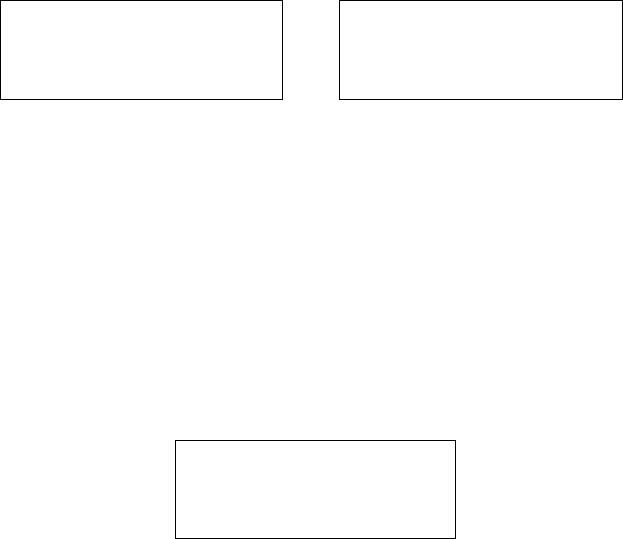
49
RC GROUP - 149_ItEn.0102
MP2000 AIR CONDITIONERS
Sistema di controllo a microprocessore per condizionatori d'aria •
Air conditioners microprocessor control system
13:30 12/02/99
Room temp. 21,5°C
Room humid. 54%rH
Unit ON Un:1
UNITA' 1 -
UNIT 1
UNITA' 2 -
UNIT 2
P : 02 Adr Priv/Shared
Trm1 01 Sh
Trm2 15 Sh
Trm3 None -- Ok? Yes
P : 05 Adr Priv/Shared
Trm1 04 Pr
Trm2 01 Sh
Trm3 15 Sh Ok? Yes
al raggiungimento del parametro UNIT NUMBER
PRESENT; quindi premere ENTER.
- Inserire il numero di unità presenti nella rete utilizzando
i tasti FRECCIA.
- Premere ENTER per confermare il dato.
- Premere HOME per tornare alla lista parametri
- Premere HOME per uscire dalla funzione.
Il numero di unità presenti nella rete deve essere memoriz-
zato sulla scheda Board "A" dell'Unità 1; quindi l'Unità 1 e
la scheda Board "A" devono sempre essere presenti in
qualsiasi configurazione della rete.
CONDIVISIONE TERMINALI
Questa funzione consente all'operatore di gestire le unità
presenti in rete dal Terminale a bordo macchina e da un
qualsiasi altro Terminale configurato come "Condiviso" (Sh).
Esempio indicativo per la configurazione LAN di una rete
composta da 2 unità collegate a Terminale Remoto "T"
dove dal Terminale dell'unità 1 è possibile accedere ad
entrambe le unità, dal Terminale dell'unità 2 è possibile
accedere solo all'unità 2 e dal Terminale Remoto "T" è
possibile accedere ad entrambe le unità.
Dove:
UNITA' 1
Trm1 Terminale a bordo macchina condiviso (Sh).
Trm2 Terminale remoto "T" condiviso (Sh).
Trm3 Nessun terminale configurato
UNITA' 2
Trm1 Terminale a bordo macchina privato (Pr).
Trm2 Terminale dell'unità 1 condiviso (Sh).
Trm3 Terminale remoto "T" condiviso (Sh).
Le eventuali unità aggiuntive verranno configurate con la
stessa procedura.
Da un qualsiasi Terminale condiviso, premendo il tasto 4
(rete LAN), si visualizzano i valori delle altre unità collegate.
dove Un:1 identifica il numero dell'unità su cui si sta
operando.
Nel caso di allarme di una unità, tutti i Terminali condivisi
visualizzano automaticamente i valori dell'unità in allarme.
ATTENZIONE!
La configurazione della rete LAN implica la perdita di
tutti i parametri macchina diversi da quelli di "Default"
come indicato nel capitolo "Elenco set".
Consultare quindi l'"Elenco set MP2000", allegato allo
schema elettrico, dove sono indicati tutti i parametri di
"Default" ed i parametri modificati.
I parametri da impostare sono contenuti in "Unit
configuration", "General parameters", "Timing
parameters" e "Program set".
press than ENTER key.
- Insert the number of units by using ARROW key.
- Press ENTER for data confirmation
- Press HOME to get back to the parameters list
- Press HOME for exit.
The number of units present in the network must be
memorized on Board "A" of the Unit 1.
Unit 1 and Board "A" always must be present in any
network configuration.
TERMINAL SHARING
This function allows to the operator all the units manage-
ment from the unit Terminal and from any Terminal with
"Sharing" (Sh) configuration.
Example for LAN configuration of a network with 2 units
connected to "T" Remote Terminal, where from unit 1
Terminal it is possible to manage both units, from unit 2
Terminal it is possible to manage only unit 2 and from "T"
Remote Terminal it is possible to manage both units.
Where:
UNIT 1
Trm1 Unit Terminal - Shared (Sh)
Trm2 "T" Remote Terminal - Shared (Sh)
Trm3 No Terminal configuration
UNIT 2
Trm1 Unit Terminal - Private (Pr)
Trm2 Unit 1 Terminal - Shared (Sh)
Trm3 "T" Remote Terminal - Shared (Sh)
Eventual additional units will be set with the same proce-
dure.
From any shared Terminal, by pressing 4 key (LAN network),
it is possible to display the values of the connected units.
where Un:1 identifies the number of the units which values
are displayed.
In case of unit in alarm condition, all shared Terminals
automatically display the alarms value of the unit.
WARNING!
The LAN network configuration will imply the loss of all
units parameters if different from the "Default" ones,
as indicated in chapter "Set list".
Check "MP2000 set list" attached to the wiring dia-
gram, where all "Default" parametres and the modify
parameters are indicated.
The parametres to be set are contained in "Unit con-
figuration", "General parameters", Timing parameters"
and "Program set".


















